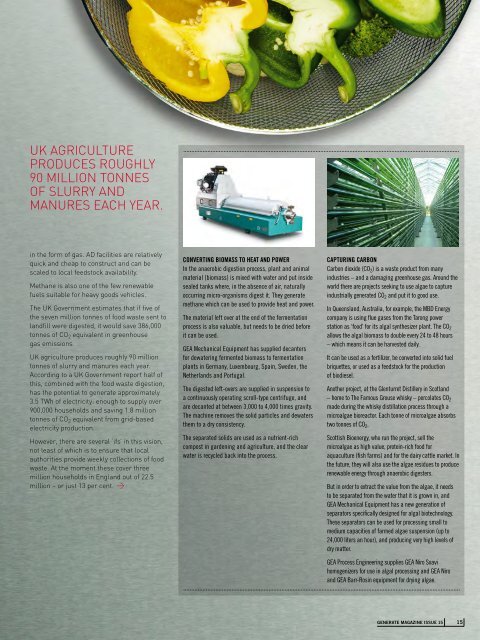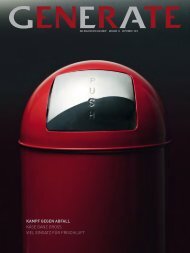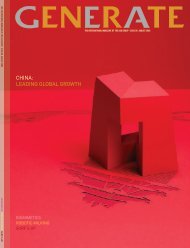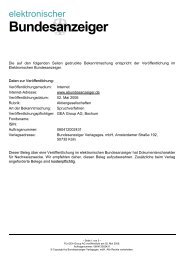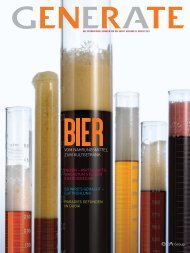A BREATH OF FRESH AIR SAY CHEESE WAR ON ... - GEA Group
A BREATH OF FRESH AIR SAY CHEESE WAR ON ... - GEA Group
A BREATH OF FRESH AIR SAY CHEESE WAR ON ... - GEA Group
You also want an ePaper? Increase the reach of your titles
YUMPU automatically turns print PDFs into web optimized ePapers that Google loves.
UK AGRICULTURE<br />
PRODUCES ROUGHLY<br />
90 MILLI<strong>ON</strong> T<strong>ON</strong>NES<br />
<strong>OF</strong> SLURRY AND<br />
MANURES EACH YEAR.<br />
in the form of gas. AD facilities are relatively<br />
quick and cheap to construct and can be<br />
scaled to local feedstock availability.<br />
Methane is also one of the few renewable<br />
fuels suitable for heavy goods vehicles.<br />
The UK Government estimates that if five of<br />
the seven million tonnes of food waste sent to<br />
landfill were digested, it would save 386,000<br />
tonnes of CO 2 equivalent in greenhouse<br />
gas emissions.<br />
UK agriculture produces roughly 90 million<br />
tonnes of slurry and manures each year.<br />
According to a UK Government report half of<br />
this, combined with the food waste digestion,<br />
has the potential to generate approximately<br />
3.5 TWh of electricity: enough to supply over<br />
900,000 households and saving 1.8 million<br />
tonnes of CO 2 equivalent from grid-based<br />
electricity production.<br />
However, there are several ‘ifs’ in this vision,<br />
not least of which is to ensure that local<br />
authorities provide weekly collections of food<br />
waste. At the moment these cover three<br />
million households in England out of 22.5<br />
million – or just 13 per cent.<br />
convErtinG biomAss to hEAt And powEr<br />
In the anaerobic digestion process, plant and animal<br />
material (biomass) is mixed with water and put inside<br />
sealed tanks where, in the absence of air, naturally<br />
occurring micro-organisms digest it. They generate<br />
methane which can be used to provide heat and power.<br />
The material left over at the end of the fermentation<br />
process is also valuable, but needs to be dried before<br />
it can be used.<br />
<strong>GEA</strong> Mechanical Equipment has supplied decanters<br />
for dewatering fermented biomass to fermentation<br />
plants in Germany, Luxembourg, Spain, Sweden, the<br />
Netherlands and Portugal.<br />
The digested left-overs are supplied in suspension to<br />
a continuously operating scroll-type centrifuge, and<br />
are decanted at between 3,000 to 4,000 times gravity.<br />
The machine removes the solid particles and dewaters<br />
them to a dry consistency.<br />
The separated solids are used as a nutrient-rich<br />
compost in gardening and agriculture, and the clear<br />
water is recycled back into the process.<br />
cApturinG cArbon<br />
Carbon dioxide (CO 2) is a waste product from many<br />
industries – and a damaging greenhouse gas. Around the<br />
world there are projects seeking to use algae to capture<br />
industrially generated CO 2 and put it to good use.<br />
In Queensland, Australia, for example, the MBD Energy<br />
company is using flue gases from the Tarong power<br />
station as ‘food’ for its algal synthesizer plant. The CO 2<br />
allows the algal biomass to double every 24 to 48 hours<br />
– which means it can be harvested daily.<br />
It can be used as a fertilizer, be converted into solid fuel<br />
briquettes, or used as a feedstock for the production<br />
of biodiesel.<br />
Another project, at the Glenturret Distillery in Scotland<br />
– home to The Famous Grouse whisky – percolates CO 2<br />
made during the whisky distillation process through a<br />
microalgae bioreactor. Each tonne of microalgae absorbs<br />
two tonnes of CO 2.<br />
Scottish Bioenergy, who run the project, sell the<br />
microalgae as high value, protein-rich food for<br />
aquaculture (fish farms) and for the dairy cattle market. In<br />
the future, they will also use the algae residues to produce<br />
renewable energy through anaerobic digesters.<br />
But in order to extract the value from the algae, it needs<br />
to be separated from the water that it is grown in, and<br />
<strong>GEA</strong> Mechanical Equipment has a new generation of<br />
separators specifically designed for algal biotechnology.<br />
These separators can be used for processing small to<br />
medium capacities of farmed algae suspension (up to<br />
24,000 liters an hour), and producing very high levels of<br />
dry matter.<br />
<strong>GEA</strong> Process Engineering supplies <strong>GEA</strong> Niro Soavi<br />
homogenizers for use in algal processing and <strong>GEA</strong> Niro<br />
and <strong>GEA</strong> Barr-Rosin equipment for drying algae.<br />
GENERATE MAGAZINE ISSUE 15 15


